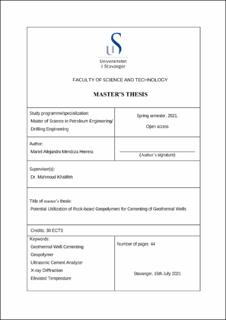| dc.description.abstract | Nowadays, the reserves of fossil fuels are running low due to the large consumption. Some few start getting interested in a type of energy that is long-lasting and free of polluting emissions, and that can be found right under our feet: the heat of the Earth. Geothermal energy is shown as one of the most promising and raises a growing interest in the set-off strategies that promote the exploitation of versatile and renewable energy sources. Three conditions must be fulfilled to have a geothermal system economically feasible for energy production: a heat source, permeability, and a waterproof layer. The cementation of geothermal wells aims to create an annular barrier between the casing and formation that can withstand the different conditions upstream, hold the casing in position, and protect the casing from formation fluids. There are several types of cement that can be utilized for geothermal wells applications. Ordinary Portland Cement (OPC) is the traditionally chosen material for zonal isolation on geothermal wells and other industries, such as oil and gas, carbon dioxide sequestration, and gas storage. For the production of OPC, there is high consumption of energy in which large amounts of carbon dioxide are released into the atmosphere. In an attempt to reduce global carbon emissions and to promote large-volume recycling of waste materials into new industrial products that could replace OPC, Geopolymers appear as an attractive option. This project is aiming to examine five different curing temperatures and periods conditions for a rock-based geopolymer recipe. They were investigated to check their applicability to be used under high-temperature conditions. From this study, It was observed that the higher and the longer the curing temperature condition is, the better the mechanical and chemical properties for the examined geopolymer samples are. | |
